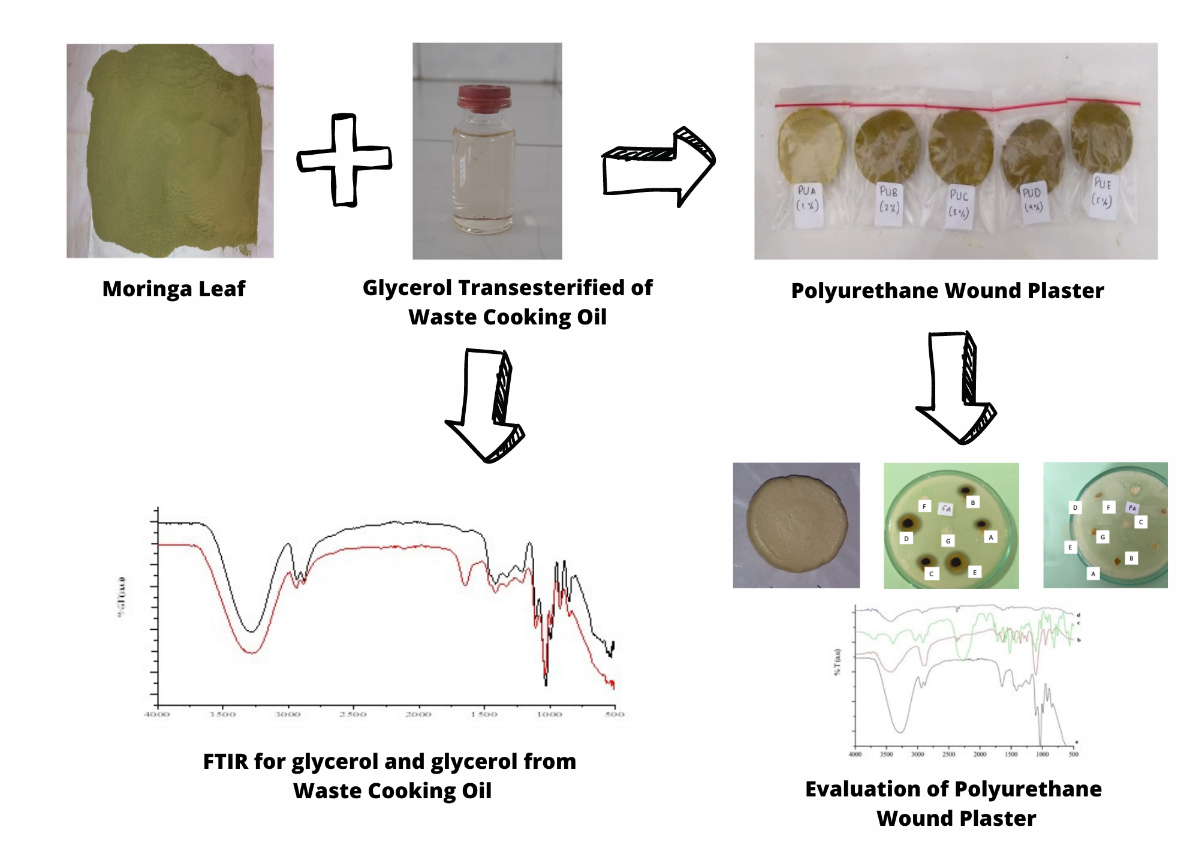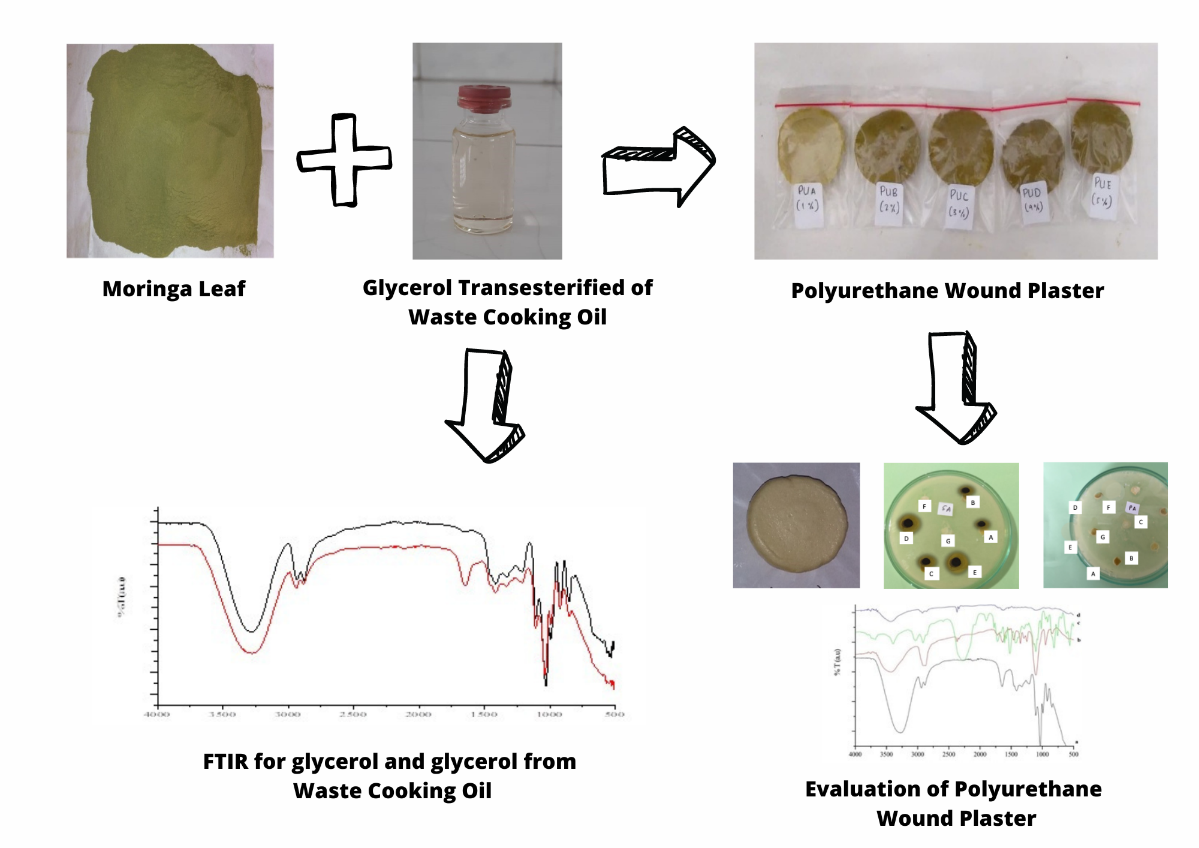Producing Polyurethane as Wound Plaster using Glycerol Transesterified of Waste Cooking Oil with Moringa Leaf Extract (Moringa Oleifera Lam.) as an Antimicrobial
DOI:
https://doi.org/10.48048/tis.2023.6963Keywords:
Glycerol of WCO (waste cooking oil), Moringa leaves, Polyurethane, Wound plaster, FT-IR, Pseudomonas aeruginosa, Staphylococcus aureusAbstract
Wound plaster polyurethane can make using glycerol from waste cooking oil (WCO). Wound plasters should contain antibacterial ingredients in addition to covering the sore. Traditionally various plants have been used to treat sore and contain sundry antibacterial chemical compounds amid Moringa oleifera Lam. Therefore, it is very potential to make polyurethane wound plasters from glycerol produced from WCO combined with Moringa leaf extract obtained from wound plasters from natural ingredients. Maceration with 96 % ethanol yielded moringa leaf extract. Then, a transesterification reaction carries out by using KOH-methanol at 60 °C to get glycerol and tested by FTIR spectrophotometry. Polyurethane wound plasters were made with a mixture of methylene 4,4 diphenyl diisocyanate, polyethylene glycol (PEG) and various formulas with variations of glycerol 0, 3, 6, 9, 12, 15 and 18 drops. A characteristic test enforced with swelling test to find the best formula and functional group analysis using FTIR spectrophotometry. Into the best wound plaster, improved Moringa leaf ethanol extract at an intensity of 1 - 5 %. An antibacterial activity test carries out on the Moringa leaf ethanol extract and plasters obtained by the agar diffusion method. The FTIR spectrophotometer test showed the formation of glycerol from WCO. The results of the characteristics test for polyurethane wound plaster preparations obtained the best formula using 3 drops of glycerol. The antibacterial activity test results at a concentration of 500 mg/mL Moringa leaf extract produced a muscular inhibition zone of 19.2 mm against Staphylococcus aureus and Antiseptic solution of 17.3 mm; Pseudomonas aeruginosa of 14.3 mm and Antiseptic solvent of 16.2 mm. Antibacterial activity of polyurethane wound plaster against Staphylococcus aureus contains 5 % ethanol extract of 10.3 mm, Plaster Merck X of 11.2 mm, Pseudomonas aeruginosa, only gave resistance at 5 % concentration of 8.3 mm and Plaster Merck X of 9.2 mm.
HIGHLIGHTS
- Based on FTIR testing, it confirms the presence of aliphatic CH groups and OH groups, as well as the comparison of FTIR spectra with the raw material indicates the presence of Glycerol from Transesterification of Used Cooking Oil, and then the purification process of glycerol from used cooking oil yielded 30.4 g
- Glycerol from the transesterification reaction of WCO is used to create polyurethane wound dressings by forming urethane groups (-NHCO), as indicated by the FTIR results of the best formula using 3 drops of glycerol
- The Moringa leaf extract in the polyurethane wound dressing formula shows antibacterial activity
GRAPHICAL ABSTRACT
Downloads
Metrics
References
Z Rani, J Reveny and U Harahap. Utilization of glycerol by product from transesterification of waste cooking oil as a cosurfactant in nanocream preparation. Int. J. Sci. Tech. Manag. 2021; 2, 1258-64.
N Suleman. 2012, Pemanfaatan limbah pemurnian gliserol hasil samping produksi biodiesel untuk pembuatan pupuk potassium. Master Thesis. Universitas Negeri Gorontalo, Gorontalo, Indonesia.
I Aziz, S Nurbayti and J Suwandari. Pembuatan gliserol dengan reaksi hidrolisis minyak goreng bekas. Chem. Progr. 2013; 6, 19-25.
I Aziz, S Nurbayti and A Rahman. Penggunaan zeolit alam sebagai katalis dalam pembuatan biodiesel. Valensi 2012; 2, 511-5.
L Adhani, I Aziz, S Nurbayti and CO Oktaviana. Pembuatan biodiesel dengan cara adsorpsi dan transesterifikasi dari minyak goreng bekas. J. Kimia Valensi 2016; 2, 71-80.
HW Tan, AA Aziz and MK Aroua. Glycerol production and its applications as a raw material: A review. Renew. Sustain. Energ. Rev. 2013; 27, 118-27.
Z Rani. 2021, Evaluasi sediaan nanokrim anti-aging dari vco (virgin coconut oil) dengan menggunakan gliserol produk samping transesterifikasi minyak goreng bekas sebagai. Master Thesis. Universitas Sumatera Utara, Sumatera Utara, Indonesia.
AG Siregar, B Syam, M Sabri, I Isranuri and S Abda. Pengaruh serat tandan kosong kelapa sawit (Tkks) pada material beton ringan (Concrete Foam). Dinamis 2015; 3, 22-33.
RA Syahputra. Pengaruh penambahan gliserol dari minyak jelantah pada pembuatan poliuretan. Jurnal Kultura 2017; 18, 6316-20.
DJ Oktaviani, S Widiyastuti, DA Maharani, AN Amalia, AM Ishak and A Zuhrotun. Artikel review: Potensi turbinaria ornata sebagai penyembuh luka dalam bentuk plester. Farmaka 2019; 17, 464-71.
HM Nasution, R Yuniarti, Z Rani and A Nursyafira. Phytochemical screening and antibacterial activity test of ethanol extract of jengkol leaves (Archidendron Pauciflorum Benth.) I.C. nielsen against staphylococcus epidermidis and propionibacterium acnes. Int. J. Sci. Tech. Manag. 2022; 3, 647-53.
RY Rafita, HM Nasution, Z Rani and F Fahmi. Utilization of Buas Buas leaf (Premna Pubescens Blume) ethanol extract as liquid soap with anti-bacteria activity. Int. J. Sci. Tech. Manag. 2022; 3, 733-43.
SM Mangale, SG Chonde, AS Jadhav and PD Raut. Study of Moringa oleifera (drumstick) seed as natural absorbent and antimicrobial agent for river water treatment. J. Nat. Prod. Plant Resour. 2012; 2, 89-100.
L Mardiana and TK Buku. Daun ajaib tumpas penyakit. Penebar Swadaya Grup, Jakarta, Indonesia, 2012.
RA Syahputra, A Sutiani, PM Silitonga, Z Rani and A Kudadiri. Extraction and phytochemical screening of ethanol extract and Simplicia of Moringa leaf (Moringa oleifera Lam.) from Sidikalang, North Sumatera. Int. J. Sci. Techn. Manag. 2021; 2, 2072-6.
D Kurniawan. 2015, Uji aktivitas antijamur ekstrak etanol daun kelor (Moringa oleifera Lamk.) terhadap Candida albicans secara in vitro (in Indonesian). Master Thesis. Universitas Tanjungpura, Pontianak, Indonesia.
SA Umar, Z Mohammed, A Nuhu, KY Musa and Y Tanko. Evaluation of hypoglycaemic and antioxidant activity of moringa oleifera root in normal and alloxan-induced diabetic rats. Trop. J. Nat. Prod. Res. 2018; 2, 401-8.
R Rambe, A Pangondian, R Paramitha, Z Rani and ED Gultom. Formulation and evaluation of hand sanitizer gel from clove flower extract (Eugenia aromatica L.). Int. J. Sci. Tech. Manag. 2022; 3, 484-91.
A Ningtias, Z Rani and Ridwanto. Formulasi sediaan pewarna pipi dalam bentuk padat dengan menggunakan ekstrak buah buni (Antidesma bunius (L.) Spreng). Jurnal Sains Teknologi 2022; 1, 448-60.
AF Pulungan, Ridwanto, GI Dalimunthe, Z Rani, R Dona, RA Syahputra and R Rambe. Phytochemical screening and antioxidant activity testing of Porang (Amorphophallus Muelleri Blume) leaf ethanol extract from Kuta Buluh region, North Sumatera. Int. J. Health Pharmaceut. 2022; 3, 1-7.
E Rohaeti. Analisis sifat termal poliuretan berbasis minyak jarak dan toluena diisosianat dengan DTA dan TGA. In: Proceedings of the Seminar Nasional Penelitian, Pendidikan dan Penerapan MIPA, Yogyakarta, Indonesia. 2011, p. K95-K108
R Fitri, HD Syahputra, N Nasri, VE Kaban and Z Rani. Formulation of a biocellulose mask containing the essence of Aloe vera (L.) Burm. f combination with vitamin E as anti-aging. ScienceRise Pharmaceut. Sci. 2022; 6, 36-42.
A Ratnawati, D Izak and A Supardi. 2013, Sintesis dan karakterisasi kolagen dari teripang-kitosan sebagai aplikasi pembalut luka (in Indonesian). Master Thesis. Universitas Airlangga, Surabaya, Indonesia.
Z Rani, Ridwanto, HM Nasution, VE Kaban, N Nasri and NB Karo. Antibacterial activity of freshwater lobster (Cherax quadricarinatus) shell chitosan gel preparation against Escherichia coli and Staphylococcus aureus. J. Appl. Pharmaceut. Sci. 2023; 13, 146-53

Downloads
Published
How to Cite
Issue
Section
License
Copyright (c) 2023 Walailak University

This work is licensed under a Creative Commons Attribution-NonCommercial-NoDerivatives 4.0 International License.






